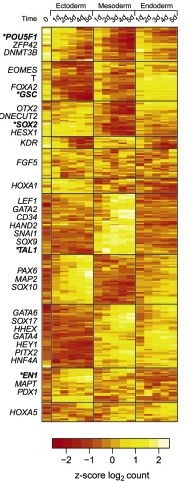 New data showing human embryonic stem cell gene expression and epigenetic activity (e.g., tagging DNA to silence specific genes) reveals that stem cells prepare early to differentiate into their next form. The research, led by HSCI Principal Faculty member Alexander Meissner, PhD, is a first look at the hundreds of thousands of changes that take place as stem cells specialize into their fated cell types.
New data showing human embryonic stem cell gene expression and epigenetic activity (e.g., tagging DNA to silence specific genes) reveals that stem cells prepare early to differentiate into their next form. The research, led by HSCI Principal Faculty member Alexander Meissner, PhD, is a first look at the hundreds of thousands of changes that take place as stem cells specialize into their fated cell types.
Meissner and Harvard Department of Stem Cell and Regenerative Biology graduate students Casey Gifford and Michael Ziller compared the extent and mechanism of how different genes are turned on and off during the differentiation of human embryonic stem cells into cells that represent the three embryonic germ layers – the ectoderm, mesoderm, and endoderm that progress into the body’s different organ systems. The huge amount of data shows the dynamics of what happens during early stem cell differentiation, but leaves open the question of how all of these genes are interacting. Meissner published the gene expression and epigenetic maps in the journal Cell as a resource for other scientists. “People can look at these maps, they can pick their favorite gene or region, and they can follow up on it,” he said.
Several interesting conclusions can already be drawn from the data. For example, at the transcriptional level, the stage where DNA is coded into messenger RNA, there are important structural differences, in the range of a few to hundreds of nucleotides, between the messenger RNA of at least 1000 genes in undifferentiated embryonic stem cells compared to differentiated stem cells.
Moreover, many genes appear to undergo orchestrated epigenetic changes before altering their expression, which Meissner presumes could prepare them for the later differentiation into specific cell types.
Meissner plans to produce more maps to closer examine the connection between early and late events in cell differentiation. “Instead of looking at all three lineages at their early time points, we will now pick certain ones and go very deep into one lineage,” he said.
The National Institutes of Health and the New York Stem Cell Foundation funded this research.
Source: Transcriptional and Epigenetic Dynamics during Specification of Human Embryonic Stem Cells. Cell. May 23, 2013.
Photo: Gene expression dynamics from stem cells to ectoderm, mesoderm, and endoderm progenitors (Credit: Meissner/Cell)
